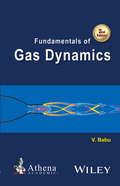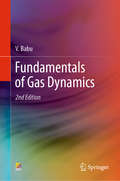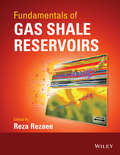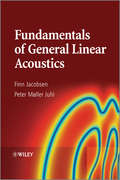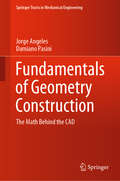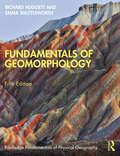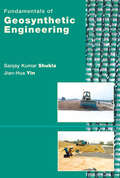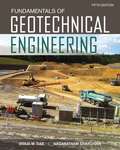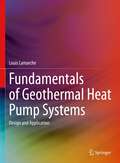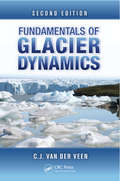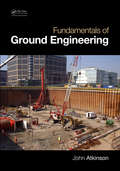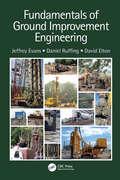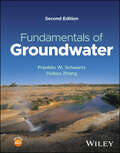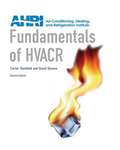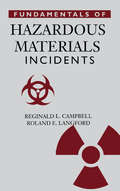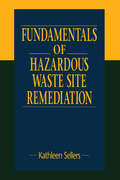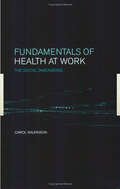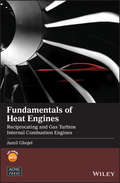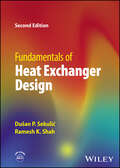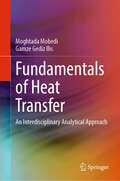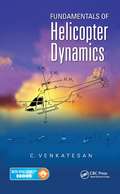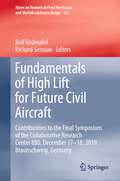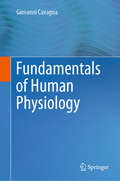- Table View
- List View
Fundamentals of Gas Dynamics
by V. BabuFundamentals of Gas Dynamics, Second Edition isa comprehensively updated new edition and now includes a chapter on the gas dynamics of steam. It covers the fundamental concepts and governing equations of different flows, and includes end of chapter exercises based on the practical applications. A number of useful tables on the thermodynamic properties of steam are also included.Fundamentals of Gas Dynamics, Second Edition begins with an introduction to compressible and incompressible flows before covering the fundamentals of one dimensional flows and normal shock waves. Flows with heat addition and friction are then covered, and quasi one dimensional flows and oblique shock waves are discussed. Finally the prandtl meyer flow and the flow of steam through nozzles are considered.
Fundamentals of Gas Dynamics (Ane/athena Bks.)
by V. BabuThis textbook on Fundamentals of Gas Dynamics will help students with a background in mechanical and/or aerospace engineering and practicing engineers working in the areas of aerospace propulsion and gas dynamics by providing a rigorous examination of most practical engineering problems. The book focuses both on the basics and more complex topics such as quasi one dimensional flows, oblique shock waves, Prandtl Meyer flow, flow of steam through nozzles, etc. End of chapter problems, solved illustrations and exercise problems are presented throughout the book to augment learning.^
Fundamentals of Gas Shale Reservoirs
by Reza RezaeeProvides comprehensive information about the key exploration, development and optimization concepts required for gas shale reservoirs Includes statistics about gas shale resources and countries that have shale gas potential Addresses the challenges that oil and gas industries may confront for gas shale reservoir exploration and development Introduces petrophysical analysis, rock physics, geomechanics and passive seismic methods for gas shale plays Details shale gas environmental issues and challenges, economic consideration for gas shale reservoirs Includes case studies of major producing gas shale formations
Fundamentals of General Linear Acoustics
by Finn Jacobsen Peter Moller JuhlAcoustics deals with the production, control, transmission, reception, and effects of sound. Owing to acoustics being an interdisciplinary field, this book is intended to be equally accessible to readers from a range of backgrounds including electrical engineering, physics and mechanical engineering. This book introduces the fundamentals of acoustic wave motion. It addresses in a clear and systematic way some of the most difficult parts of acoustics for beginners, such as the widely different approximations due to the wide frequency range, the apparently arbitrary choice between the use of analytical solutions to the wave equation with boundary conditions, and the fundamentally different energy-based considerations used in noise control. As a result, it provides readers with a self-contained source of information on acoustics which can be used for self-study or as a graduate course text. Key features: Places an emphasis on detailed derivations based on the fundamental laws of physics and interpretations of the resulting formulas. Avoids, where possible, electrical and mechanical equivalent circuits, so as to make it accessible to readers with different backgrounds. Introduces duct acoustics, sound in enclosures, and sound radiation and scattering. Contains a set of appendices which includes material on signal analysis and processing as these tools are essential for the modern acoustician.
Fundamentals of Geometry Construction: The Math Behind the CAD (Springer Tracts in Mechanical Engineering)
by Jorge Angeles Damiano PasiniThe textbook provides both beginner and experienced CAD users with the math behind the CAD. The geometry tools introduced here help the reader exploit commercial CAD software to its fullest extent. In fact, the book enables the reader to go beyond what CAD software packages offer in their menus. Chapter 1 summarizes the basic Linear and Vector Algebra pertinent to vectors in 3D, with some novelties: the 2D form of the vector product and the manipulation of “larger" matrices and vectors by means of block-partitioning of larger arrays. In chapter 2 the relations among points, lines and curves in the plane are revised accordingly; the difference between curves representing functions and their geometric counterparts is emphasized. Geometric objects in 3D, namely, points, planes, lines and surfaces are the subject of chapter 3; of the latter, only quadrics are studied, to keep the discussion at an elementary level, but the interested reader is guided to the literature on splines. The concept of affine transformations, at the core of CAD software, is introduced in chapter 4, which includes applications of these transformations to the synthesis of curves and surfaces that would be extremely cumbersome to produce otherwise. The book, catering to various disciplines such as engineering, graphic design, animation and architecture, is kept discipline-independent, while including examples of interest to the various disciplines. Furthermore, the book can be an invaluable complement to undergraduate lectures on CAD.
Fundamentals of Geomorphology (Routledge Fundamentals of Physical Geography)
by Richard Huggett Emma ShuttleworthThis revised and updated edition continues to provide a comprehensive introduction to the subject, exploring the world’s landforms from a broad systems perspective. It covers the basics of Earth surface forms and processes, while reflecting on the latest developments in the field. Fundamentals of Geomorphology begins with a consideration of the nature of geomorphology, including its relation to society, process and form, history, and geomorphic systems, and moves on to discuss: • Structure: structural landforms associated with plate tectonics and those associated with volcanoes, and folds, faults, and joints. • Process and form: landforms resulting from, or influenced by, the exogenic agencies of weathering, running water, flowing ice and meltwater, ground ice and frost, the wind, and the sea; landforms developed on limestone; extraterrestrial landforms; and landscape evolution, a discussion of ancient landforms. Fundamentals of Geomorphology provides a stimulating and innovative perspective on the key topics and debates within the field of geomorphology. Written in an accessible and lively manner, it includes guides to further reading, chapter summaries, and an extensive glossary of key terms. The book is also illustrated throughout with over 200 informative diagrams and attractive photographs, all in colour. It is supported by online resources for students and instructors.
Fundamentals of Geosynthetic Engineering
by Sanjay Kumar Shukla Jian-Hua YinThe development of polymeric materials in the form of geosynthetics has brought major changes to the area of Civil Engineering. Increasing interest in these materials and their use has resulted in significant advances in their practical applications in the last few decades. Following this progress, geosynthetics have become a common and favoured co
Fundamentals of Geotechnical Engineering
by Nagaratnam Sivakugan Braja DasFUNDAMENTALS OF GEOTECHNICAL ENGINEERING, 5E offers a powerful combination of essential components from Braja Das' market-leading books: PRINCIPLES OF GEOTECHNICAL ENGINEERING and PRINCIPLES OF FOUNDATION ENGINEERING in one cohesive book. This unique, concise geotechnical engineering book focuses on the fundamental concepts of both soil mechanics and foundation engineering without the distraction of excessive details or cumbersome alternatives. A wealth of worked-out, step-by-step examples and valuable figures help readers master key concepts and strengthen essential problem solving skills. Prestigious authors Das and Sivakugan maintain the careful balance of today's most current research and practical field applications in a proven approach that has made Das' books leaders in the field.
Fundamentals of Geothermal Heat Pump Systems: Design and Application
by Louis LamarcheFundamentals of Geothermal Heat Pump Systems: Design and Application is written for upper-level undergraduate and graduate courses in renewable energy and heat transfer. This classroom-tested text covers ground heat exchanger modeling, secondary loop ground-source system design, pumping energy, thermal response testing, commercial building applications, and horizontal and groundwater ground heat exchangers. The book is oriented to practical applications, including the economic analysis of ground source heat pump (GSHP) systems, but more theoretical sections are provided covering research-related geothermal applications. Chapters on heat transfer fundamentals and heat pump concepts are included for readers less familiar with thermal engineering concepts. A chapter covering the economic analysis of GSHP systems is also included. All of the examples and problems in the book are solved using the open-source Python programming language.The book will provide students in geothermal energy courses with a solid understanding of the subject. It will also be a valuable reference for professionals working in the field of renewable energy.
Fundamentals of Glacier Dynamics
by C.J. van der VeenMeasuring, monitoring, and modeling technologies and methods changed the field of glaciology significantly in the 14 years since the publication of the first edition of Fundamentals of Glacier Dynamics. Designed to help readers achieve the basic level of understanding required to describe and model the flow and dynamics of glaciers, this second edi
Fundamentals of Ground Engineering
by John AtkinsonFundamentals of Ground Engineering is an unconventional study guide that serves up the key principles, theories, definitions, and analyses of geotechnical engineering in bite-sized pieces. This book contains brief-one or two pages per topic-snippets of information covering the geotechnical engineering component of a typical undergraduate course in
Fundamentals of Ground Improvement Engineering
by David Elton Jeffrey Evans Daniel RuffingGround improvement has been one of the most dynamic and rapidly evolving areas of geotechnical engineering and construction over the past 40 years. The need to develop sites with marginal soils has made ground improvement an increasingly important core component of geotechnical engineering curricula. Fundamentals of Ground Improvement Engineering addresses the most effective and latest cutting-edge techniques for ground improvement. Key ground improvement methods are introduced that provide readers with a thorough understanding of the theory, design principles, and construction approaches that underpin each method. Major topics are compaction, permeation grouting, vibratory methods, soil mixing, stabilization and solidification, cutoff walls, dewatering, consolidation, geosynthetics, jet grouting, ground freezing, compaction grouting, and earth retention. The book is ideal for undergraduate and graduate-level university students, as well as practitioners seeking fundamental background in these techniques. The numerous problems, with worked examples, photographs, schematics, charts and graphs make it an excellent reference and teaching tool.
Fundamentals of Groundwater
by Franklin W. Schwartz Hubao ZhangFundamentals of Groundwater A thoroughly updated classic on the fundamentals of groundwater The second edition of Fundamentals of Groundwater delivers an expert discussion of the fundamentals of groundwater in the hydrologic cycle and applications to contemporary problems in hydrogeology. The theme of the book is groundwater, broadly defined, and it covers the theory and practice of groundwater—from basic principles of physical and chemical hydrogeology to their application in traditional and emerging areas of practice. This new edition contains extensive revisions, including new discussions of human impacts on aquifers, and strategies and concepts for sustainable development of groundwater. It also covers the theory of groundwater flow—including concepts of hydraulic head and the Darcy equation—and ground water/surface water interactions, as well as geochemistry and contamination. Readers will also find A thorough introduction to the techniques of water resource investigations and regional groundwater flow Comprehensive explorations of groundwater chemistry and its applications in regional characterization and assessments of health impacts Practical discussions of groundwater contamination and water sustainability more generally Fulsome treatments of newly emerged contaminants, like PFAS, pathogens, agricultural contaminants, methane, arsenic, uranium, and redox processes Perfect for undergraduate and graduate students taking courses in hydrogeology, groundwater, geoscience, applied geoscience, and groundwater and contaminant processes, Fundamentals of Groundwater also benefits environmental consultants, geochemists, engineers, and geologists.
Fundamentals of Guided-Wave Optoelectronic Devices
by William S. C. ChangOptoelectronic guided-wave devices are used in a wide range of optical fiber communication and optoelectronic systems. In such networks, the electrical and the optical characteristics of guided-wave devices, and the interplay between them, have a profound effect on system design and overall performance. Uniquely, this book combines both the optical and electrical behavior of guided-wave optoelectronic devices so that the interwoven properties, including interconnections to external components, are easily understood. It provides the key concepts and analytical techniques that readers can apply to current and future devices. It also presents the impact of material properties on guided-wave devices, and emphasizes the importance of time-dependent interactions between electrical and optical signals. This is an ideal reference for graduate students and researchers in electrical engineering and applied physics departments, as well as practitioners in the optoelectronics industry.
Fundamentals of HVACR (2nd Edition)
by Carter Stanfield David SkavesCreated with a clear-cut vision of necessary knowledge, this groundbreaking text provides comprehensive coverage of heating, ventilating, air conditioning, and refrigeration. Lauded as a reader-friendly text that delivers fundamental concepts, the most current trends, and practical applications with simple language and skillfully presented concepts, Fundamentals of HVACR, 2nd edition is everything readers need to know to install, service, and maintain HVACR systems.
Fundamentals of Hazardous Materials Incidents
by Reginald Campbell R. Everett LangfordThis book evolved from the course developed at the U.S. Department of Labor's National Mine, Health, and Safety Academy to develop the legislation that eventually became 29 CFR 1910.120.Fundamentals of Hazardous Materials Incidents offers the reader a basic understanding of the principles involved in toxicology, federal regulations, respiratory protection, personal protective equipment, radiation, environmental considerations, industrial hygiene sampling, site safety, and chemically resistant suits. Thousands of people have been trained using this manual, now revised and available for the first time in hardcover format. The book is essential for identifying potential problems at hazardous waste sites, covers diverse topics throughout the area of hazardous materials response, and is ideal for training courses to meet 29 CFR 1910.120 requirements. Quantity discounts available.
Fundamentals of Hazardous Waste Site Remediation
by Kathleen SellersEvery practicing environmental engineer should already have a firm grasp on the basics of hazardous waste site remediation-the key to confronting a site problem, and devising an effective solution.Since their original introduction to remediation, technology has kept moving ahead with new ideas and procedures. Fundamentals of Hazardous Waste Site Remediation gives environmental professionals immediate access to the basics of the trade, along with information about recent advancements.This comprehensive overview examines the basics of such areas as hazardous materials chemistry, hydrogeology, reaction engineering, and clean-up level development. A chapter on Cost Estimating will be of particular interest to specialists, in light of recent concerns about the increased costs of remediation. After reading each chapter, test your new knowledge with the review problems.As a refresher guide for career environmental engineers, or a helpful tool to newcomers in the field, Fundamentals of Hazardous Waste Site Remediation is a valuable resource for longtime professionals and newcomers alike.
Fundamentals of Health at Work
by C. WilkinsonFundamentals of Health at Work is an engaging re-assessment of workplace health, with particular emphasis on the neglected issues of the social context of the working environment and the impact on individuals of their workplaces. In looking at the historical context of the subject and at the concepts of health and illness, a selective series of tho
Fundamentals of Heat Engines: Reciprocating and Gas Turbine Internal Combustion Engines (Wiley-ASME Press Series)
by Jamil GhojelSummarizes the analysis and design of today’s gas heat engine cycles This book offers readers comprehensive coverage of heat engine cycles. From ideal (theoretical) cycles to practical cycles and real cycles, it gradually increases in degree of complexity so that newcomers can learn and advance at a logical pace, and so instructors can tailor their courses toward each class level. To facilitate the transition from one type of cycle to another, it offers readers additional material covering fundamental engineering science principles in mechanics, fluid mechanics, thermodynamics, and thermochemistry. Fundamentals of Heat Engines: Reciprocating and Gas Turbine Internal-Combustion Engines begins with a review of some fundamental principles of engineering science, before covering a wide range of topics on thermochemistry. It next discusses theoretical aspects of the reciprocating piston engine, starting with simple air-standard cycles, followed by theoretical cycles of forced induction engines, and ending with more realistic cycles that can be used to predict engine performance as a first approximation. Lastly, the book looks at gas turbines and covers cycles with gradually increasing complexity to end with realistic engine design-point and off-design calculations methods. Covers two main heat engines in one single reference Teaches heat engine fundamentals as well as advanced topics Includes comprehensive thermodynamic and thermochemistry data Offers customizable content to suit beginner or advanced undergraduate courses and entry-level postgraduate studies in automotive, mechanical, and aerospace degrees Provides representative problems at the end of most chapters, along with a detailed example of piston-engine design-point calculations Features case studies of design-point calculations of gas turbine engines in two chapters Fundamentals of Heat Engines can be adopted for mechanical, aerospace, and automotive engineering courses at different levels and will also benefit engineering professionals in those fields and beyond.
Fundamentals of Heat Exchanger Design
by Dusan P. Sekulic Ramesh K. ShahFundamentals of Heat Exchanger Design A cutting-edge update to the most essential single-volume resource on the market Heat exchangers are thermal devices which transfer heat between two or more fluids. They are integral to energy, automotive, aerospace, and myriad other technologies. The design and implementation of heat exchangers is an essential skill for engineers looking to contribute to a huge range of applications. Fundamentals of Heat Exchanger Design, Second Edition provides a comprehensive insight into the design and performance of heat exchangers. After introducing the basic heat transfer concepts and parameters, an overview of design methodologies is discussed. Subsequently, details of design theory of various types of exchangers are presented. The first edition established itself as the standard single-volume text on the subject. The second edition preserves an established in-depth approach but reflects some new technological developments related to design for manufacturing compact heat exchangers, including novel 3-D printing approaches to heat exchanger design. Readers of the second edition of Fundamentals of Heat Exchanger Design will also find: A new section on the design for manufacturing of compact heat exchangers A new section on design for additive manufacturing compact heat exchangers Detailed discussions of the design of recuperators and regenerators, pressure drop analysis, geometric parameters, heat transfer correlations, and more Fundamentals of Heat Exchanger Design is ideal for practicing engineers, as well as for advanced undergraduate and graduate students in mechanical and aerospace engineering, energy engineering, and related subjects.
Fundamentals of Heat Transfer: An Interdisciplinary Analytical Approach
by Moghtada Mobedi Gamze Gediz IlisThis book demonstrates the analytical solution of fundamental problems in heat transfer which covers conduction, convection, and radiation heat transfer. The analytical solution of heat transfer problems is described in a simple way which is easy to understand. This book also provides competence of solving fundamental heat transfer problems by analytical method which is particularly important to gain a strong background on heat transfer. The book is an interdisciplinary heat transfer book which is useful for all academicians and students from different disciplines with different levels of mathematical knowledge. The book can be used as a core or supplementary textbook in undergraduate and graduate bridge courses. Furthermore, it is suitable for professional and vocational coursework for technology and engineering professionals.
Fundamentals of Helicopter Dynamics
by C. VenkatesanHelicopter Dynamics Introduced in an Organized and Systematic MannerA result of lecture notes for a graduate-level introductory course as well as the culmination of a series of lectures given to designers, engineers, operators, users, and researchers, Fundamentals of Helicopter Dynamics provides a fundamental understanding and a thorough overview o
Fundamentals of High Frequency CMOS Analog Integrated Circuits
by Yusuf Leblebici Duran LeblebiciThis textbook is ideal for senior undergraduate and graduate courses in RF CMOS circuits, RF circuit design, and high-frequency analog circuit design. It is aimed at electronics engineering students and IC design engineers in the field, wishing to gain a deeper understanding of circuit fundamentals, and to go beyond the widely-used automated design procedures. The authors employ a design-centric approach, in order to bridge the gap between fundamental analog electronic circuits textbooks and more advanced RF IC design texts. The structure and operation of the building blocks of high-frequency ICs are introduced in a systematic manner, with an emphasis on transistor-level operation, the influence of device characteristics and parasitic effects, and input–output behavior in the time and frequency domains. This second edition has been revised extensively, to expand some of the key topics, to clarify the explanations, and to provide extensive design examples and problems. New material has been added for basic coverage of core topics, such as wide-band LNAs, noise feedback concept and noise cancellation, inductive-compensated band widening techniques for flat-gain or flat-delay characteristics, and basic communication system concepts that exploit the convergence and co-existence of Analog and Digital building blocks in RF systems. A new chapter (Chapter 5) has been added on Noise and Linearity, addressing key topics in a comprehensive manner. All of the other chapters have also been revised and largely re-written, with the addition of numerous, solved design examples and exercise problems.
Fundamentals of High Lift for Future Civil Aircraft: Contributions to the Final Symposium of the Collaborative Research Center 880, December 17-18, 2019, Braunschweig, Germany (Notes on Numerical Fluid Mechanics and Multidisciplinary Design #145)
by Rolf Radespiel Richard SemaanThis book reports on the latest numerical and experimental findings in the field of high-lift technologies. It covers interdisciplinary research subjects relating to scientific computing, aerodynamics, aeroacoustics, material sciences, aircraft structures, and flight mechanics. The respective chapters are based on papers presented at the Final Symposium of the Collaborative Research Center (CRC) 880, which was held on December 17-18, 2019 in Braunschweig, Germany. The conference and the research presented here were partly supported by the CRC 880 on “Fundamentals of High Lift for Future Civil Aircraft,” funded by the DFG (German Research Foundation). The papers offer timely insights into high-lift technologies for short take-off and landing aircraft, with a special focus on aeroacoustics, efficient high-lift, flight dynamics, and aircraft design.
Fundamentals of Human Physiology
by Giovanni CavagnaThis textbook explores the fundamental qualitative and quantitative aspects of human physiology. It approaches biological and physiological processes and phenomena from a quantitative perspective, revealing how physiological problems can be mathematically formulated starting from simple laws of physics. The book addresses a broad range of topics, including: the statics and dynamics of circulation; muscle and sarcomere force-length and force-velocity relations, together with their mechanisms and functional consequences; subdivisions and meaning of the heat produced by muscle; locomotion, statics and dynamics of respiration; diffusion of gases and acid base equilibrium; phonation; general functions of the kidney and of the different sections of the nephron; changes in clearance with a substance’s plasmatic concentration; pH regulation and the kidney; Donnan’s equilibrium and its consequences; and the Nernst equation. The book offers the ideal learning resource for students of human physiology courses in medicine and biomedicine, as well as biomedical engineering and biophysics graduate students. An elementary grasp of mathematics and physics is sufficient to understand the content.
